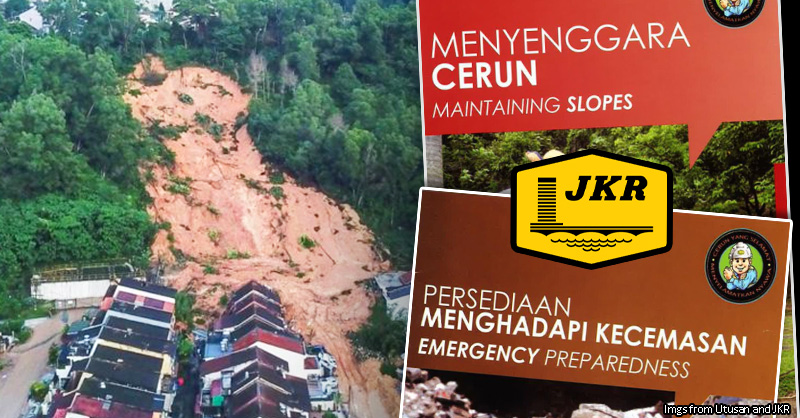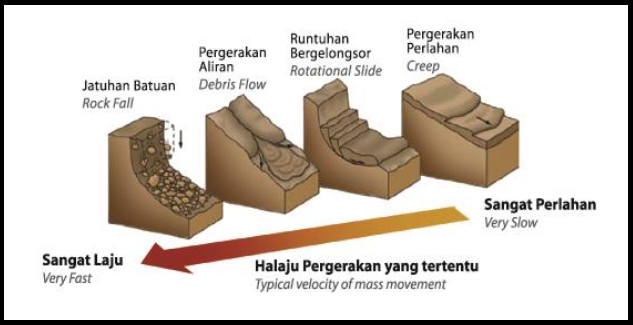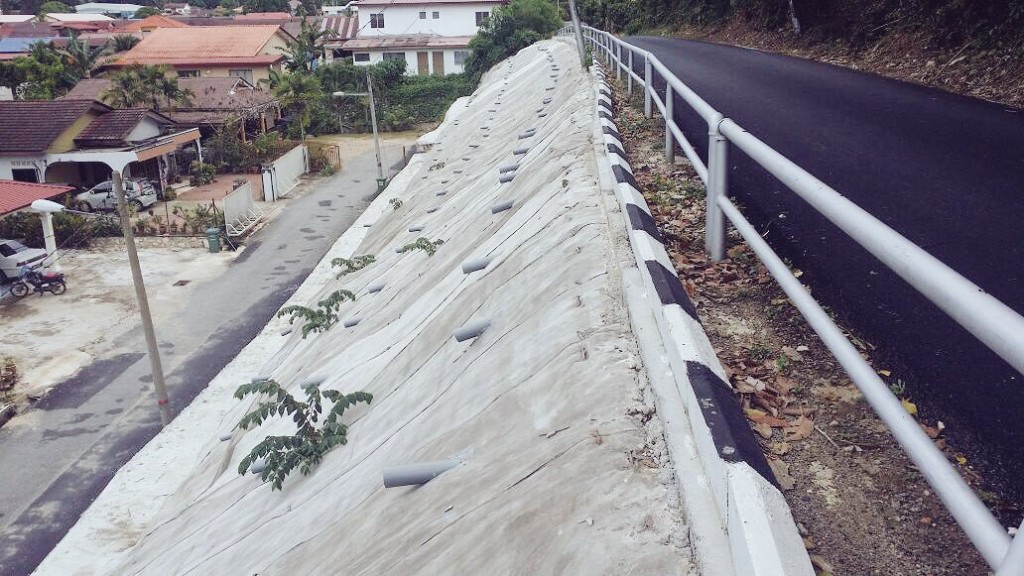What to do during a landslide according to JKR, and how to detect them early

On Friday, 16 December 2022, Malaysians were shocked by a massive landslide that occurred in the wee hours of the morning at a campsite in Batang Kali, near Genting Highlands. Dubbed the worst tragedy so far this year, the landslide buried 94 campers. As of 10 pm on Friday, 61 had been rescued, 21 passed away (including 4 children), and 12 have yet to be found.

The aftermath of the Batang Kali landslide. Img from BERNAMA.
While the details of the incident are yet to be determined, it should be noted that this is the 23rd landslide reported nationwide this year. Landslides are unfortunately a common thing in Malaysia, with a 2011 report estimating an average of 100 landslides – whether they’re reported or not – happening each year. With that in mind, perhaps it’s worth learning a thing or two about why landslides happen in Malaysia, how you can detect them early, and what to do if you’re at risk from one.
Starting with why they happen so often…
Continuous rain and development are common factors in Malaysian landslides
While there are many possible factors that may cause it, the three big culprits to look out for when it comes to Malaysian landslides are slopes, development, and heavy rain. The first one is pretty self-explanatory: landslides are land sliding down a slope after all.

Types of landslides and the speeds at which they happen. Img from JKR.
The second one, development, needs a bit of understanding. Flat areas ideal for construction are scarce, and we often have to artificially create those flat areas by cutting slopes in hilly areas. Properly done, it’s less of a problem, but if poorly maintained or cut too steep, they tend to become unstable. The earth cut from those slopes may also be poured down the sides of other slopes, creating a loose layer of land that may become a landslide in the future.
Aside from artificial slopes, other forms of development may also increase the risk of landslides. Deforestation or clearing a slope of vegetation removes the plants that help hold the slope together with their roots, and constructing building on slopes puts a load on the soil layers beneath it, pushing them down. A nearby mine or quarry may also set up a future landslide: if they use explosives to break up rocks, the soil layers can slowly be shaken loose.

Img from JKR.
If all of these development factors are the different fillings of a terrible landslide sandwich, then heavy rain is the bread that ties them all together. The massive amounts of water brought by prolonged rain further weakens the structure of already weakened slopes, triggering landslides. So if you’re in a hilly area that shows signs of development or simply a place with a lot of slopes this rainy season, remember to be vigilant against landslides.
But what if you live in such an area?
Check your slopes for dangerous signs every year
While they try to be, the government isn’t fully responsible for every single slope in the country. On private property, for example, the responsibility of assessing and maintaining slopes falls on the owner, and JKR had published a brochure on how to do a simple slope maintenance and inspection.
Commonly, to reduce the risk of landslides, retaining walls are built into steep slopes to contain the earth, with weep holes built into it to let water out. Less steep slopes are covered with either guniting (a sort of cement-sand glue), stone pitching, fabric covers, or vegetation, like bamboo orchids (Arundina graminifolia) and that blue flower used to color nasi kerabu (Clitoria ternaeta). Good water flow is also maintained through the building of channel and drains.

A slope reinforced with guniting, with pipes jutting out of the weep holes. Img from CCMalaysia’s Twitter.
Maintenance is essentially making sure that these measures are holding up well, so it’s recommended to inspect these at least once a year. This involves, among other things, making sure there is grass/vegetation on the slopes, inspecting weep holes and drains for blockages, seeing if there are cracks or potentially crack-causing plants on reinforced slopes, checking drains for debris, and looking out for damaged drains and water pipes, as trapped water can weaken the slope.
If you’re familiar with the area, you can also keep an eye out for signs that show that a slope is failing, or in the process of sliding. If you own a home on top or near a slope, you can notice the signs of slope failure on your house: cracks, obviously, and structures moving from their original positions, like a staircase or pillar that suddenly moves forward a bit or something. You may notice slanting power lines or trees as well. An interesting sign is a door or window jamming for the first time; that might indicate that your house just got crooked recently.

Keep an eye out for new cracks. Img from SuretyProperty.
Outside, roads may develop cracks that widen with time, and since water plays a big part in landslides, unexplained puddles appearing in new places or gushing out from inappropriate places can be warning signs, too. This can also manifest in bulges at the base of a slope-retaining wall or water just plain oozing out of a slope’s base. When these signs occur, you can report it to JKR’s Slope Engineering Branch (CKC) by calling them at 1-300-888-557 or 03-2610 8888.
While spotting these tell-tale signs may help reduce your risk of experiencing a landslide, sometimes bad things can still happen. So…
Here’s what you can do in the event of a landslide
If you live in a high-risk area, the JKR recommends you prepare for the possibility of landslides by outlining what you should do before, during, and after a landslide.
Before:
- Develop an evacuation plan, i.e. know beforehand where to go and identify possible alternative roads you can take to get out. Also, have a bag filled with essentials that you can take at a moment’s notice.
- Learn about emergency response and discuss it with your family members.
- Be vigilant of signs of land movement around your home, such as small, falling rubble or water accumulating on slope surfaces. Noticing small changes can give you a head start in the event of a landslide.

Some recommended grab bag contents. Screengrabbed from JKR.
During:
- Inform your neighbors that a landslide is happening/about to happen, as they may be unaware. If possible, help those who need assistance to evacuate.
- If possible, evacuate as soon as you can while avoiding the path the land is sliding to. If you have to be move near a landslide, run across the landslide’s path rather than away from the slide direction.
- If you’re trapped inside a house, a better bet would be to move to an upper floor, as the ground floor often gets destroyed by the land flowing through it.
- Curl up into a ball under a strong object, like a table. If you’re trapped outside, find the nearest stable object and curl up in a ball under it.

An example given in the brochure. Screengrabbed from JKR.
After:
- Stay away from the landslide area as there may be additional landslides. Look out for warning signs such as the sound of trees cracking or debris falling down the slide.
- Check for trapped survivors as soon as you determined it’s safe, and direct rescuers to their location. Generally, the estimated window of time for survival is two hours.
- Watch out for floods, which sometimes follow landslides. Stay away from broken electricity cables, and avoid standing in water when they’re about.
- Keep an eye on the latest emergency information through radio, TV, or social media.
- Look for and report broken utility lines to the authorities. This will help them get deactivated quicker, preventing further hazards.
- Help out those who may need extra assistance – infants, elderly people, OKUs, large families, and those without transportation – by taking them to a relief or operations center.
